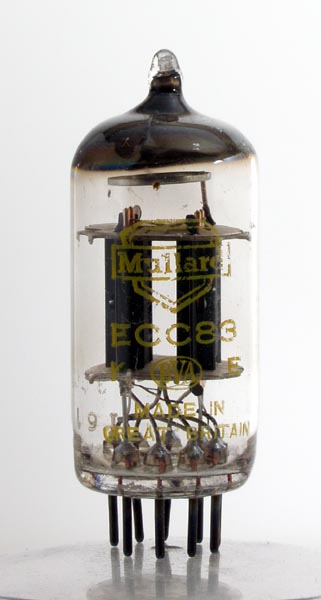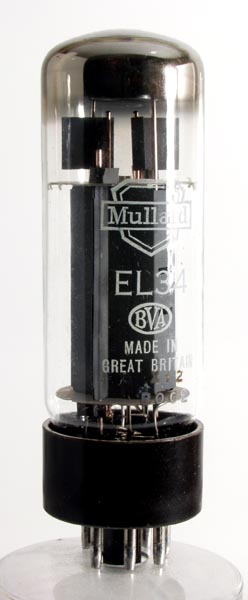|
Mechanical Construction of Valves
The Valve Technology series has mainly concentrated on the electrical characteristics of valves, since these are important for the circuit designer. However, the manufacture of valves, though of no concern to the designer or user, is equally fascinating and as a subject warrants inclusion in an industrial museum! (That's what I thought in 1999 - Ed.)
It has become obvious that glass was chosen for the envelope because of its ease of manufacture, material consistency, strength under compression to contain a vacuum and its tolerance to wide temperature variations, and was, logically enough, developed from the light bulb. It is also obvious that the plug-in type of valve is almost universal for easy replacement in the event of failure or ageing (but also because it's not a good idea to solder directly to glass embedded metal connections), hence the base pin connections and the use of chassis sockets.

The Mullard ECC83
In those types where the insides can be easily viewed through the glass, the construction will be clearly seen. The valve components are spot-welded together into a support structure which typically comprises vertical rods carried in horizontal sections of mica or similar. However, getting this assembly into the glass envelope is NOT the same as putting a model ship in a bottle!
In fact the envelope begins its life as two parts, the envelope proper, and a glass base (See EF80 Construction). In B9A valves, this base also carries the plug-in connection pins which need an involved glass-to-metal seal and bonding process to prevent leaks (in octal valves these are solid core lead-out wires because the plug-in base is separate). These bases are usually supplied to the valve assembler prefabricated. The valve assembly is spot-welded to the base connections, then the whole slid into the envelope whereupon the two glass parts are joined by gas flame.
The envelope is then pumped to evacuate it. B9A valves have the small diameter exit tube on top of the envelope, octal valves have it in the centre of the base at the bottom. Initially mechanical pumping is used, but this is unable to achieve a sufficient vacuum on its own, so at the point when no more can be removed by this method the operation is switched over to a mercury vapour pump. Ideally the air content should be reduced to an order of 10-7atmospheres.
When the number of remaining gas molecules has been reduced to the necessary scarcity, the exit tube can be closed by melting it with a gas flame. This action leaves behind the ever present pip on the top of B9A valves. In the case of octal valves, the plastic base carrying the plug pins would be glued on and the lead-out wires soldered into the hollow pins.
But the device is not ready to be used yet. On examining a valve's innards you will also find metal rings or other curiously redundant structures, with what looks like patches of chromium plate on the inside of the envelope, none of which apparently has anything to do with the way the valve works when in use. You'd be right. These are the 'getter rings', and the silvery stuff is the getter material. The getter ring form is most common, they can be found at the top of many B9A envelopes, but variations are not unusual.

The Mullard EL34
For example some examples of the GZ34 rectifier have their getter ring encircling the base, whereas the EL34 power pentode has two small rectangular platforms supported on single rods at the top.
On assembly this structure carries a compound embedded in channels or depressions. After evacuation, the final operation is to insert the finished valve into an RF heater which is aligned to the getter ring. The ring is heated to boil off the compound, which deposits an oxide layer on the inside of the glass in the vicinity of the ring. The oxide is only stable in a vacuum, as its property is one of quickly absorbing air molecules. As such then, the material not only depletes the last remaining air further, but also traps any gases that may be given off by electrodes while in use. A case where the glass has cracked and let all the 'air' in is easy to spot. The getter material will have turned completely chalky white.
|